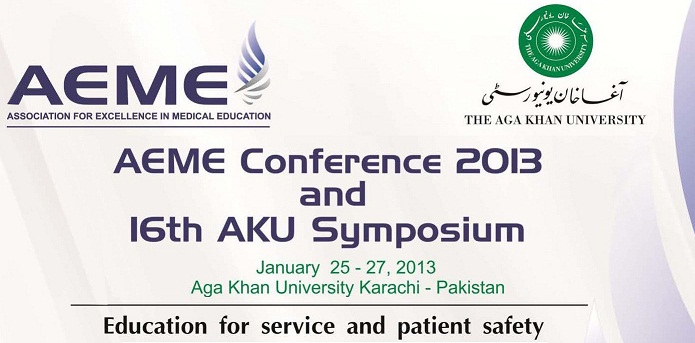Day 2 : Oral Presentations (Theme: Curriculum - Teaching & Learning)
The effects of changed teaching modalities on the efficacy of Advanced Cardiac Life Support program
Location
Lecture Hall 3
Start Date
27-1-2013 8:40 AM
Abstract
Introduction: The course content and guidelines of ACLS are reviewed approximately every five years by the American Heart Association (AHA) ,for modifications in the management recommendations, as indicated by the scientific literature. In ACLS 2005 amendments were also made to the teaching techniques of the program. The main purpose of these modifications was to ensure the maximum efficacy of the ACLS program.
In the developing countries, limited data is available to determine the effect of teaching modalities to validate the ACLS program. Therefore, a study was conducted to evaluate the effectiveness of the teaching strategies and methodologies in the program. This was achieved by comparing end of course test scores of group (2012) with changed teaching methodologies to the previous group (2011). Changed teaching modalities and teaching strategies were applied only on group 2 and are listed in table 1 given below.
Method: Two ACLS programs were conducted, one in 2011 and the other in 2012.
Group 1(2011) and group2 (2012) consisted of 26 and 24 participants respectively .The distribution of audience according to their disciplines are listed in table 2 .
Changed teaching modalities and teaching strategies were applied only on group 2 and are listed in table1
It was a knowledge and skilled based test comprising of 40 questions on CPR, emergency drugs, Advanced airways, cardiac rhythms and mega code. The duration of the test was 40 min. Then data was collected and analyzed in SPSS version 17
Students 58.33%
Residents 31.25%
Senior faculty 10.42%
Table2 showing distribution of participants according to their levels
Result: The result was notified via email and posted outside skills lab. Data was analyzed for significant difference in the two tests. The mean score for model 1 ACLS was 28.6 with a standard deviation of 5.38, whereas the mean score for Model 2 ACLS was 35.2 with a standard deviation of 2.35.Therefore we found the two groups to have a significant difference in the scores of the final test with a p valve of <0.001.
Conclusion: Slight modification in the prescribed AHA format according to our local perspective has a highly significant effect on the knowledge, skills, and competencies attained during ACLS program.
The effects of changed teaching modalities on the efficacy of Advanced Cardiac Life Support program
Lecture Hall 3
Introduction: The course content and guidelines of ACLS are reviewed approximately every five years by the American Heart Association (AHA) ,for modifications in the management recommendations, as indicated by the scientific literature. In ACLS 2005 amendments were also made to the teaching techniques of the program. The main purpose of these modifications was to ensure the maximum efficacy of the ACLS program.
In the developing countries, limited data is available to determine the effect of teaching modalities to validate the ACLS program. Therefore, a study was conducted to evaluate the effectiveness of the teaching strategies and methodologies in the program. This was achieved by comparing end of course test scores of group (2012) with changed teaching methodologies to the previous group (2011). Changed teaching modalities and teaching strategies were applied only on group 2 and are listed in table 1 given below.
Method: Two ACLS programs were conducted, one in 2011 and the other in 2012.
Group 1(2011) and group2 (2012) consisted of 26 and 24 participants respectively .The distribution of audience according to their disciplines are listed in table 2 .
Changed teaching modalities and teaching strategies were applied only on group 2 and are listed in table1
It was a knowledge and skilled based test comprising of 40 questions on CPR, emergency drugs, Advanced airways, cardiac rhythms and mega code. The duration of the test was 40 min. Then data was collected and analyzed in SPSS version 17
Students 58.33%
Residents 31.25%
Senior faculty 10.42%
Table2 showing distribution of participants according to their levels
Result: The result was notified via email and posted outside skills lab. Data was analyzed for significant difference in the two tests. The mean score for model 1 ACLS was 28.6 with a standard deviation of 5.38, whereas the mean score for Model 2 ACLS was 35.2 with a standard deviation of 2.35.Therefore we found the two groups to have a significant difference in the scores of the final test with a p valve of <0.001.
Conclusion: Slight modification in the prescribed AHA format according to our local perspective has a highly significant effect on the knowledge, skills, and competencies attained during ACLS program.

